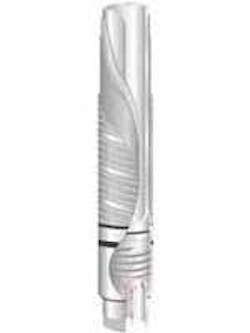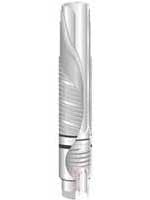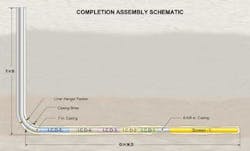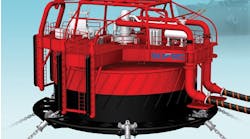Inflow control method improves gravel packing of horizontal completions
By Christian F. Bayne,
Knut Henriksen
Baker Oil Tools
Managing production from long horizontal sections poses a number of challenges to operators. Some key elements among these concerns are effectively controlling inflow from the reservoir and ensuring that the entire length of the interval is producing, while minimizing the influx of undesired fluids, such as water and/or gas, into the wellbore at or near the heel (casing shoe).
The inflow control device uses a helical flow channel that acts as the restrictive element and imposes a pressure distribution along the entire length of the wellbore.
In a concerted effort, these challenges were addressed in a recent 11,894 ft extended-reach well in the Troll Field, where Norsk Hydro and Baker Oil Tools used a completion method centered around a stand-alone screen assembly and a specially designed inflow control device.
The completion of the M-22 well required a total of 279 joints of 0.010 gauge, 250 micron, Excluder 2000 and Equalizer ICD (inflow control device) screens, which were installed in the single horizontal section. The well was directionally drilled to a total depth of 18,113 ft at a true vertical depth of 5,177 ft.
The screen assembly was hung off from the bottom of a non-rotating, hydraulically set liner hanger with a liner top packer, and set inside 10-3/4 in. casing. The ICDs were positioned along the horizontal open-hole section to balance and effectively control production inflow along the entire length of the open-hole section. All completion equipment was supplied in 13-chrome material.
Norsk Hydro used this same type of system previously to manage production in horizontal wells in the Troll Field. However, the M-22 well represented the first time an open-hole completion length of just less than 12,000 ft had been attempted.
Joint design, development
If left unchecked, a long horizontal well with no inflow control will have the greatest pressure differential at the heel. As a result of flowing oil in the base pipe, the pressure difference between the toe (the point of lowest flow rate) and the reservoir boundary will be near zero. Additionally, the pressure difference between the heel and the reservoir boundary will be at its maximum. It is this pressure difference in the heel that causes early water and/or gas breakthrough. A joint effort between the companies defined the methodology, and developed the reservoir depletion system to alleviate the problem.
The completion of the M-22 well required a total of 279 joints of 0.010 gauge, 250 micron, Excluder2000 and Equalizer ICD screens, which were installed in the single horizontal section.
The main objective of this technology is to maximize recovery through uniform productivity along the length of the extended lateral section. A balanced inflow profile gives the operator the option of increasing drawdown pressure while reducing the risk of early water and/or gas breakthrough.
Components
The primary components of the system are an extended longevity well screen and a specially designed inflow control device. The well screen jacket has a single-layer vector membrane with uniform pore throat openings and inflow comparable to that of a formation face in order to ensure well productivity by resisting plugging and erosion.
The inflow control device uses a helical flow channel that acts as the restrictive element and imposes a pressure distribution along the entire length of the wellbore. The result is the first completion system to successfully create a uniform, self-regulating production profile along the entire length of the horizontal wellbore.
When used in a wellbore zone that is known to be close to a water-oil contact, this system can help restrict production to delay water breakthrough. Similarly, high-permeability streaks can be effectively "throttled back" to preclude early water and/or gas breakthrough.
Mathematical models that describe the pressure drop characteristics have been developed and verified. Other models that describe the impact of this completion design on the reservoir currently are under development.





